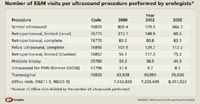Article
Data raise questions about bladder ultrasound usage
Bladder ultrasound is noninvasive and relatively easy to perform, which may explain its increased usage in recent years. However, the American Board of Urology has expressed concern that urologists may be overusing the test. In this exclusive Urology Times interview, Pat Fulgham, MD, president of Urology Clinics of North Texas, Dallas, discusses data on the dramatic shift in bladder ultrasound usage by some urologists. Dr. Fulgham, who teaches an annual AUA course on ultrasound, also discusses clinical and reimbursement guidelines clinicians should follow. The interview was conducted by UT Editorial Consultant Robert C. Flanigan, MD, professor and chairman of the department of urology, Loyola University Medical Center, Maywood, IL.
Bladder ultrasound is noninvasive and relatively easy to perform, which may explain its increased usage in recent years. However, the American Board of Urology has expressed concern that urologists may be overusing the test. In this exclusive Urology Times interview, Pat Fulgham, MD, president of Urology Clinics of North Texas, Dallas, discusses data on the dramatic shift in bladder ultrasound usage by some urologists. Dr. Fulgham, who teaches an annual AUA course on ultrasound, also discusses clinical and reimbursement guidelines clinicians should follow. The interview was conducted by UT Editorial Consultant Robert C. Flanigan, MD, professor and chairman of the department of urology, Loyola University Medical Center, Maywood, IL.

A We have had the impression over the last several years that the frequency of post-void residual (PVR) measurement by ultrasound was increasing significantly. While the validity of post-void residual measurement has long been a topic of discussion, there is no question that PVR is widely used by urologists for a variety of clinical indications. When we evaluated Medicare data from the years 2000, 2002, and 2003 we saw a dramatic increase in the number of ultrasound PVR measurements (CPT 51798) submitted by urologists when compared with the number of patients seen in the office . For example, in 2000, one post-void residual measurement was performed for every 31.4 office visits. By 2003, one post-void residual was performed for every 8.3 visits.
The other ultrasound examination that has increased significantly has been renal ultrasound (CPT 76775) and appropriately so.
Q Medicare data show that patient visits to urologists have increased significantly, from seven million in 2000 to eight million in 2003. Is that, in your mind, a legitimate reason for the increase, or are urologists overusing ultrasound?
A With over a million more Medicare E&M codes submitted in 2003 than in the year 2000, the increased number of ultrasound procedures is a combination of increased utilization and not just increased patient volume. Whether or not urologists are overusing ultrasound is a much more difficult judgment. For example, I happen to find the PVR a less useful clinical tool than some of my partners. However, my decision to measure PVR has nothing to do with the technology used to measure it. I think it is more meaningful to ask whether PVR is being overutilized rather than whether ultrasound is being overutilized.

The danger is in using the procedure routinely without regard to changes in clinical signs or symptoms. A problem with PVR is that very little data exist on how useful it is. There is a great deal of intraindividual and interindividual variability with PVR. While some studies have shown that an increased PVR may correlate well with flow rate, other studies have shown that pretreatment PVR correlates very poorly with the outcomes of medical therapy and minimally invasive procedures. I have the sense that right now PVR is sometimes being used because it gives the urologist some sense of comfort. It provides a noninvasive and facile way to show that patients are not in chronic urinary retention and that they are likely not developing dilated upper urinary tracts or renal insufficiency. It has become a sort of security blanket approach to long-term management.
Q What about an extreme case of a urologist who does a post-void residual on every patient before seeing them, no matter whether it's the first time or their 31st time being in the office? Can that be justified in any way?

















